How do I even tell this story? Of all the tuna fishing expeditions we’ve made the last few years, this might have been the pinnacle of our journeys to the Gulf of Mexico. The secret is out – sportfishermen around the world have heard tales of giant yellowfin tunas blasting baits in the shadows of deep water oil rigs and back breaking fights which cripple men who are unprepared for the strain of titan class tunas.
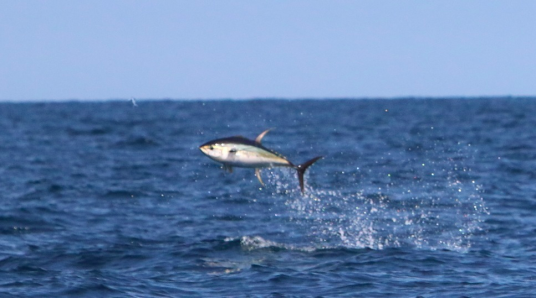
Venice, LA sits at the shores of a bountiful and largely untamed bluewater eden – the culmination of tuna angling in the United States. For us, giant yellowfin tuna fishing in The Gulf is an odyssey into a sport fishing legacy which has been carried by the crew of Paradise Outfitters in Venice, LA for more than a decade.
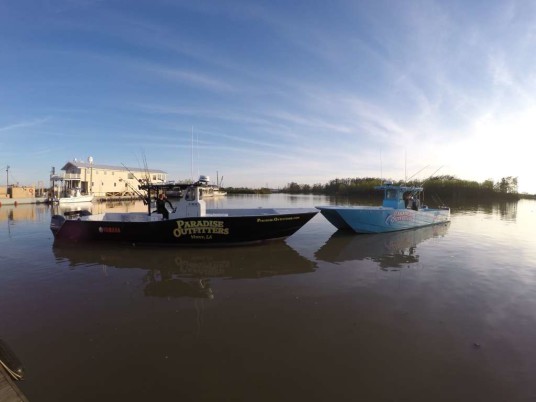
Our previous expeditions with Capt. Hunter Caballero and Capt. Scott Leger put us on the line with 145lb tunas crashing cull behind shrimp boats and chunking for 60-80lb tunas at the midnight lump. They are stories best told with pictures than words -adventures that have evolved into enduring memories which compel us to return, over and over again, to the deep water rigs – in search of that perfect moment, where in a fit of fury, impeccable bluewater predators humble us with their strength. There is no greater battle, no greater reward, than fighting these fish in their element with some of the finest gear on the planet.
Our pilgrimage to Louisiana landed us in the heart of New Orleans late in the afternoon, two days before St. Patricks day. Tourists from all over the country, adorned in green shirts, fo-gold chains, and purple beaded necklaces, clogged the entrance to one of our favorite culinary sanctuaries upon arrival – the Harbor Seafood and Oyster House. Despite the agonizing 35 minute wait for a dose of NOLA fried goodness, patience delivered us to a fitting meal of swamp platters before our commute to the lower delta.
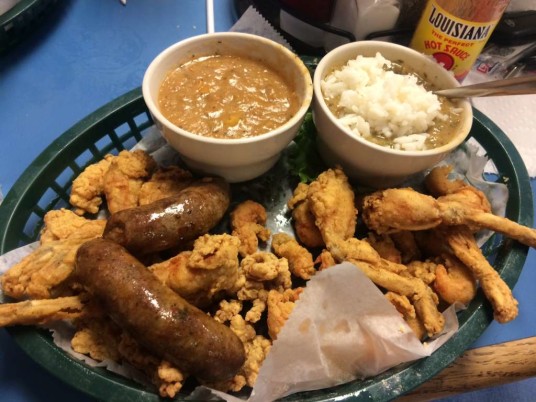
The trip to Venice, LA is a tour through the country side – long stretches of low country road unimpeded by the droves of cars which pour into and out of New Orleans every day. Our late afternoon arrival and swap platter feast put us into Cypress Cove Marina shortly after 7:30, which meant darkness, mosquitos, and a fitting hike out to the new luxury house boat which shelters the crew of Paradise Outfitters.
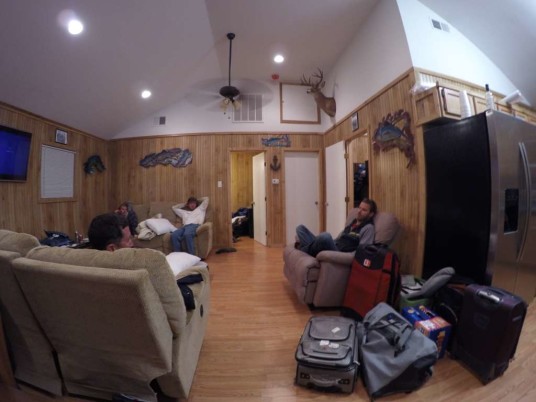
An oasis of a private sport fishing lodge, the house boat is unlike any I have previously encountered. Once inside, you’d never know you weren’t in a downtown condo in anywhere USA. Adorned in a few reminders of trophy fish, scattered foul weather gear, and coolers -the boat itself sported three bedrooms, a full kitchen, dining area and lounge. What was perhaps most striking about the operation is that the entire Paradise Outfitters fleet was docked immediately on, well, the front porch. This is the design and incarnation of charter fishing fantasy – to have your boat, loaded and ready, just ten steps from your front door. That would be torture in almost any other lifestyle.
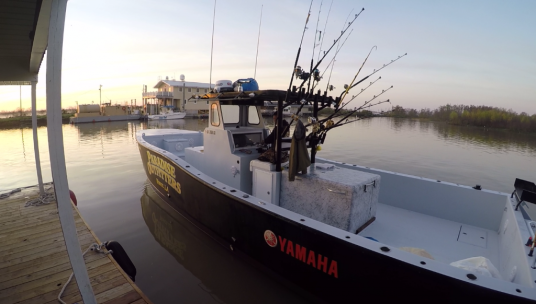
Day 1 – The New Boat and Top Water Tunas
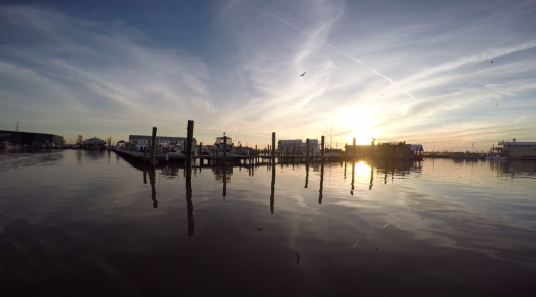
Dawn on the Mississippi is entrancing. Icy river water meets piercing sun, which casts an eerily timeless fog across the harbor. The ominous roar of tankers making their way up and down the tumultuous currents of the Mississippi reverberated through the dock-house as the crew made ready for departure.
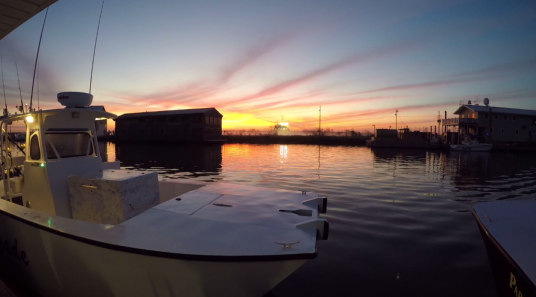
0700 is an on-time start for the PO crew, whose customers wait with tremendous anticipation to begin their journey. As a fitting start to our expedition, we had the privilege of joining Capt. Hunter aboard his brand new 41′ Fin Cat.
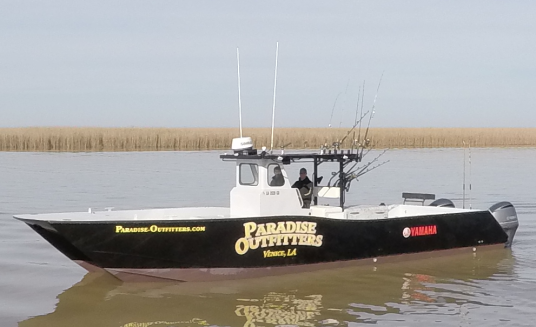
The boat is massive, commanding, and resembles a vehicle more fit for amphibious assault by Seal Team Two than a fishing vessel – but it’s performance is undeniable. It’s hard to appreciate just how enormous and perfectly designed this boat is until you experience it in person.
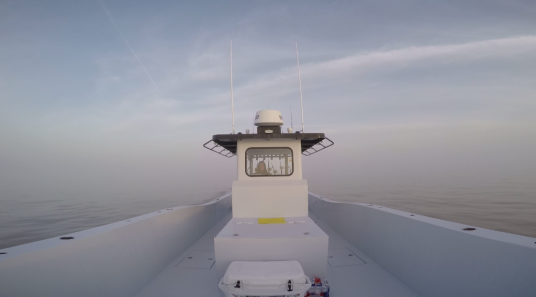
This is the successor to Hunter’s original Fin Cat – boasting a slightly larger control console and a few performance “enhancements” following lessons learned running the original blue boat more than four seasons.
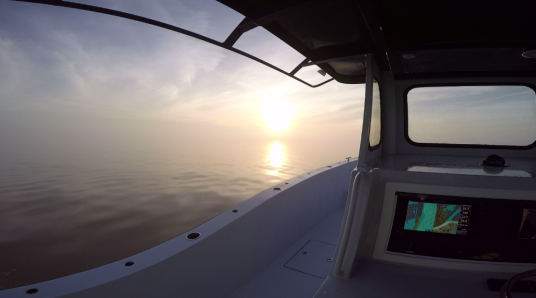
We charged down the Mississippi through a frigid wash of mud stained water, chopped lilly pads, and logs – carried down river from the voluminous thaw of northern snow. 40 degree water temperature at 715 in the morning was a chilling reminder of the harsh winter that crushed most of the U.S the past few months. We passed a variety of tankers just arriving from an enduring ocean journey as we made our way to the pass – many of them casting a brilliant silhouette in the fresh dawn.
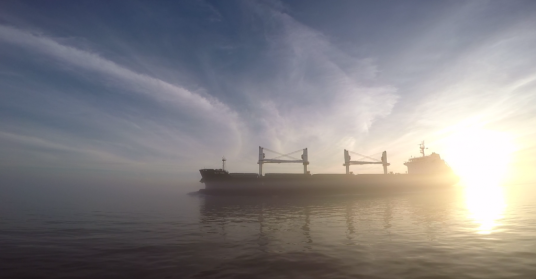
As the sun rose and gave way to warmth, we arrived to the mouth of the river and passed, unobstructed into moderately calm seas.
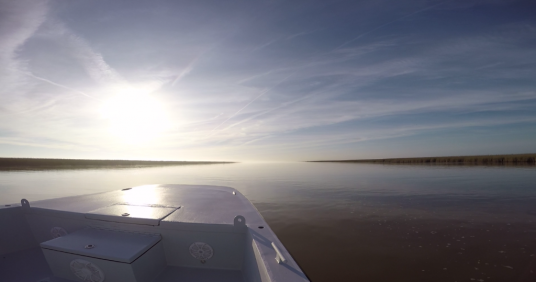
Our last several expeditions with the Paradise crew put us into steep chop which made navigation challenging on the 40 mile run to the floating deep water rigs. Thrilled at the concept of finally fishing in agreeable weather – our plan was simple. Find giant tunas, and catch them on top water plugs.
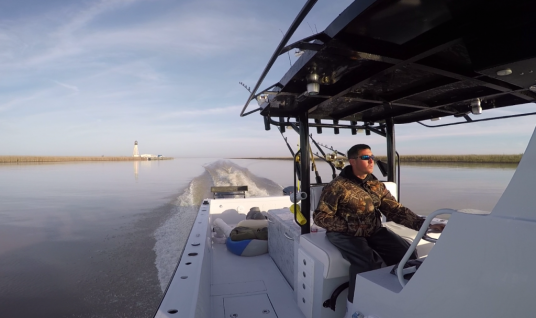
One of Hunter’s shining accolades is his infallible ability to find fish when the odds are stacked against him. Day after day, after day, after day – Hunter finds the bite for his clients. You would be hard pressed to find another Captain as seasoned and well versed in the techniques of catching trophy fish in the seemingly bottomless Gulf of Mexico. What’s most amazing about fishing in The Gulf is the staggering absurdity of the landscape. 40 miles out of the pass, towering in the distance are, for all intensive purposes, what look like space stations on the horizon. The presence of these super structures is visually overwhelming – a solemn reminder of the machines which power the world with petroleum. The contrast of bluewater against these titanic hulks of steel, aluminum, iron, and cable is unnerving as much as it is surreal. The bounty of life which thrives in the shadows and coils which descend from the rigs is nothing short of confounding.
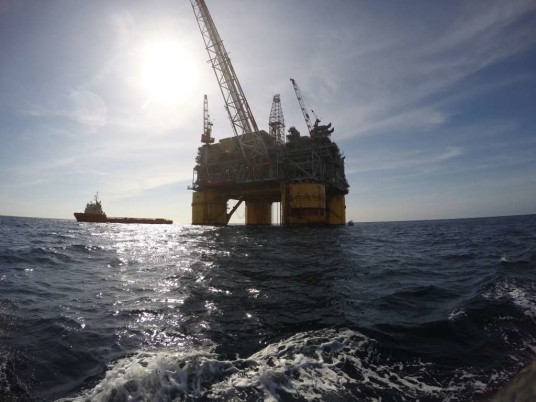
We arrived to the rig under sunny skies, pleased to find bait swimming on the surface and tunas lurking below. Marking yellowfins upon arrival to a rig, as clearly as Hunter’s Simrad’s do, instigates a cascade of emotions which can best be described as one part anxiety, one part pain, and one part melt your face off excitement. To know our quarry is just a few hundred feet below, actively prowling for food – well, that’s something which you need to feel to understand.
We began a broad side drift, slowly chunking our way across the North side of the rig with blackfin tuna for bait. As if on queue during our first drift of the expedition, the line snapped out of my hand, went tight for a split second, then slack. I had missed it. The first bite of the trip, and I had missed it. Defeat. A sensation which is familiar when tuna chunking. A swift decisive transition from free spool to strike on the drag lever is mandatory in order to drive the circle hook home. It’s a technique which takes some practice – and after you miss the bite of what could be a legendary tuna – you repeat the process to yourself over, and over, and over again – until it becomes instinctive. On the second set, we welcomed the first fish to the boat – a smaller specimen which earned a trip to the ice box after a quick, albeit stubborn fight, to the surface.

In quick succession, the bite begin to pick up – and a few more small tunas came to the boat. Scott landed our first keeper of the day, boating a nice 30lb fish fit for the dinner table. Into the ice with the fish and then, in one of those fleeting moments where time goes “slow mo” I saw what would ultimately become our destiny that day – an enormous bust. Disbelief, followed by mlld panic, as another bust gave way to a hulking fish hurling itself through the air. My mind didn’t exactly process what I was seeing as a shower of ballyhoo exploded about 150 yards away, followed by an eruption of hundred pound tunas in hot pursuit. Explosion, after explosion, after explosion.
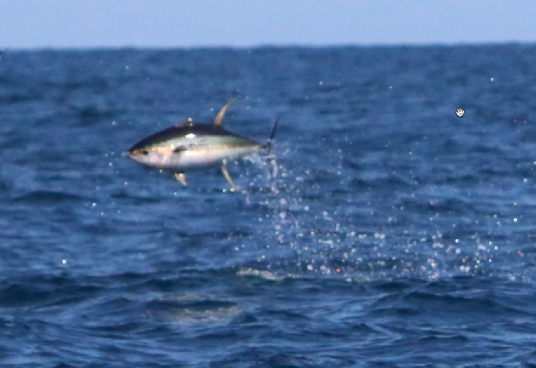

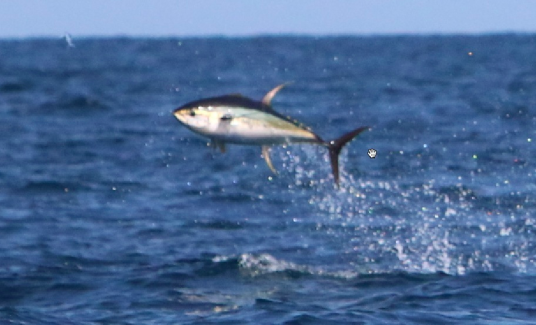
Giant tunas began rocketing out of the water in an orchestrated blitz against panicked baitfish. All lines in, and we began our charge towards the school. The busts were all around us – taunting us in a tantalizing display of aerial fury.
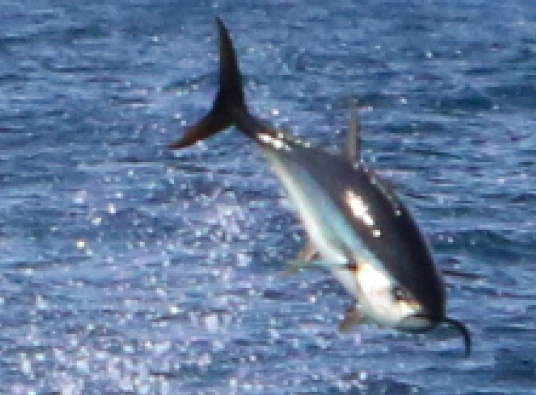
I heaved the plug off the bow and began ripping it across the surface. Nothing. More busts. I heaved the plug again, digging deep into the surf casting roots of my Atlantic beach soul to maximize distance – the plug set down next to an eruption. One more chug – and – boom! Another fleeting moment that will remain forged in my mind as one of the single greatest tuna moments of my life – a hundred plus pound tuna exploded on the plug – knocking it high into the sky. The fish soared through air with it’s mouth open waiting for the plug to fall – but it didn’t. Zero gravity. The force. I don’t know. The yo-zuri just kept soaring through the air as the tuna crashed back into the water. The plug plopped down a few seconds later. I was quivering with frustration, but still overjoyed. A conundrum which is indescribable. I heard the rattle of the plug as the tuna blasted it, but the razor sharp treble hooks did not find a home. The image of that fish exploding into the sky, it’s mouth agape in anticipation of a meal – my plug just out of reach – was painful, but truly and thoroughly sensational. The school leapt off into the distance. We pursued.
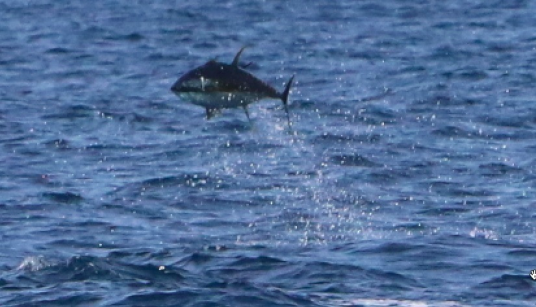
Apparently the real trick, when tunas are jumping in a synchronized assault on bait around an oil rig is to “match the hatch” and drag a rigged ballyhoo while waiting with a popper ready to throw. The school continued to bound in the distance – going away from us, then coming back. A second shot was in store. The tunas, now leaping 5 to 10 feet in the air, pounded their way back towards the boat as Hunter made a slow steady turn towards them – to head them off on their trajectory. The busts grew closer, and closer – the stern rod got nailed and started screaming! Scott hooked up – another bust – another – close enough to cast. I heaved the plug viciously and landed it just 30 yards off the bow. A slow steady draw on the plug gave way to another furious explosion – as if i was tied to a truck – the rod bent over sharp in my hands, then slack, then sharp, then slack, then…it sounded. I’ve fought many, many powerful fish on jigging tackle, but this was an explosion of weight and fury unlike anything I have ever held in my hands. The plug was fixed in that tunas mouth and I have never felt a spinning reel rip that hard in my life. The run would just not end and the braid poured off the Penn Clash with the power of a dozen amberjacks. Incredible. What was likely a four minute run felt like a 1/2 hour by the time the fish quit diving and I was able to make headway. Fighting a 60+lb yellowfin on a jig rod is no joke – it took all of my arms and most of my lower back to pull that fish to submission. It was a fight which just would not end – give and take went on for about 25 minutes while Scott fought another impressive yellowfin at the stern. It was glorious to see that first top water tuna show color at the boat. Rising up from the deep with his brilliant amber sides and razor defined sickles dragging in the current. The thud of the gaff in that fish wasn’t nearly as satisfying as the scream of the drag, but I suppose that’s because I knew the fight was over. Not that I could have handled much more. Despite weeks of physical training in preparation for the trip, my lower back was burning!
What a privilege to be one of the first people in the world to catch a top water yellowfin tuna on the Penn Clash!
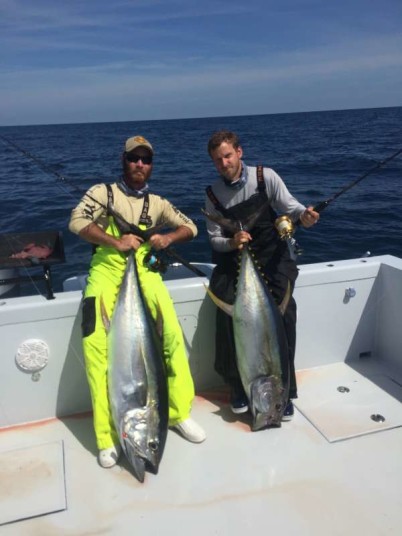
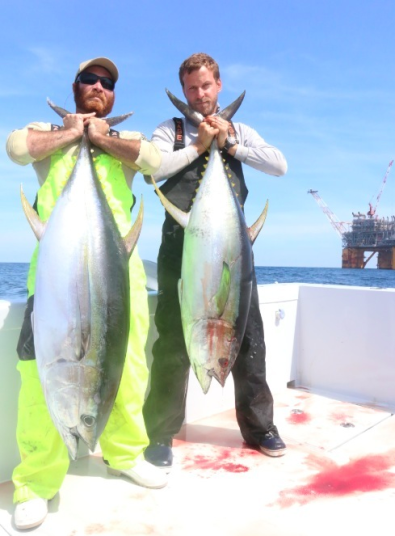
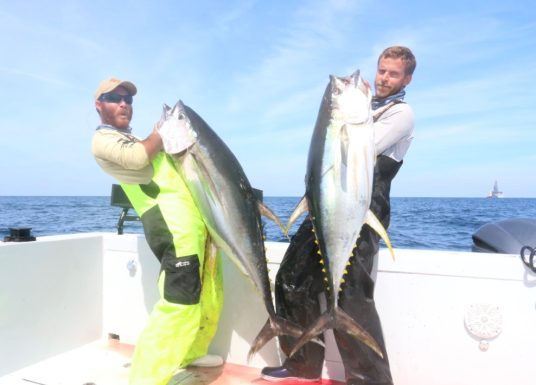
As the excitement drew down aboard Hunter’s boat, the day still had much, much in store for us. The tunas continued to leap and bound their way across the surface – their distance shifting with every minute. The constant eruption of fleeing ballyhoo and flying fish kept our adrenaline flowing as tunas continued to demonstrate their aerial capability. One after another, after another. The surface blitz continued. We went back to chunking, this time a bit farther out from the rig with a drift to intercept the tunas as they wandered to and from the shadow of the URSA. Now fervent in their dedication to follow suit in my top water spoils, Scott and Todd took turns throwing the popper as far as they could. Each cast of that popper kept everyone fixated on the lure as we methodically drew out our lines to keep the chunks going. Boom! Again, another yellow exploded on the popper and began absolutely ripping straight down.
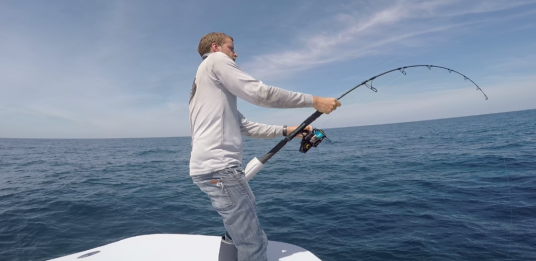
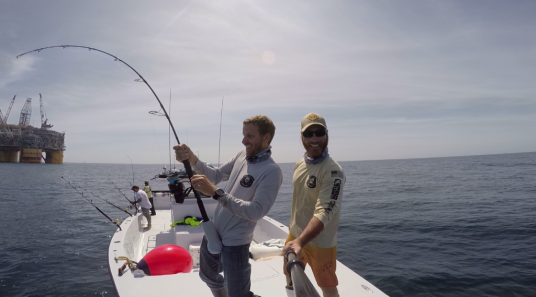 This time Scott was on the rod and began drawing the fish up slowly. Give and take went on for about 20 minutes before the fish reluctantly made its way to the surface. Another incredible top water tuna!
This time Scott was on the rod and began drawing the fish up slowly. Give and take went on for about 20 minutes before the fish reluctantly made its way to the surface. Another incredible top water tuna!
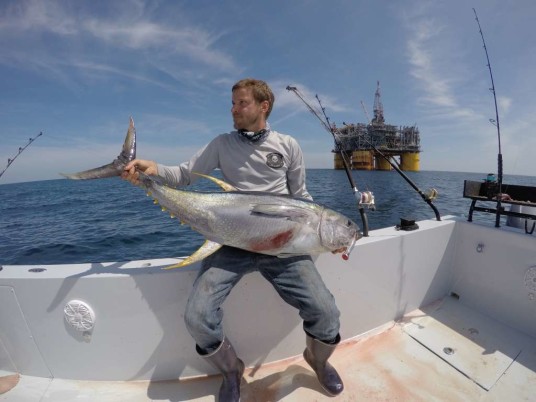
The satisfaction is just unparalleled. The adrenaline soaked experience of witnessing the ferocity of a yellowfin tuna pound a top water popper is surpassed only by that first blistering run. Nothing can touch it. Nothing.
We went on that day to boat three fish on top water plugs, the highlight being a group of 50 to 70lb tunas fighting each other for the popper as Scott ripped it across the surface. In a profound moment of absurdity, when the infallible Captain Hunter glanced up just in time to see a tuna leap out of the water just a few feet off the bow to engulf Scott’s popper – in mid air – he quipped a quick “oh s***!”. That about summed it up. It’s rare you get to hear a seasoned Captain get just as excited as us – this was truly a special occasion, when top water blitzing giant yellowfin tunas decided to cooperate – and our tackle held up.
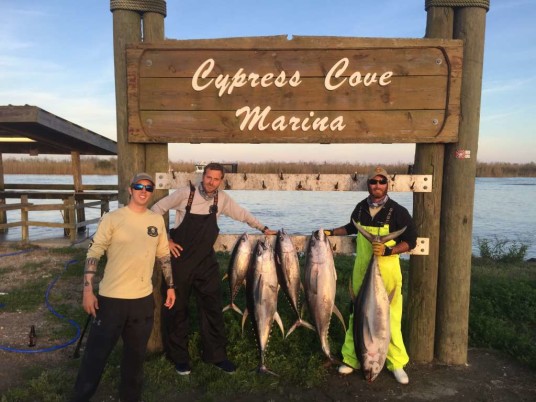
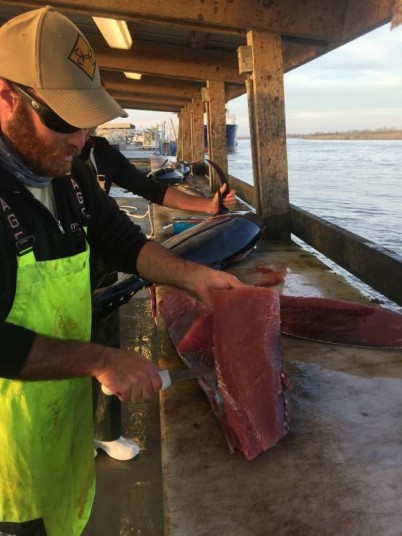
Day 2 – Exploring New Ground and a Deep Water Surprise
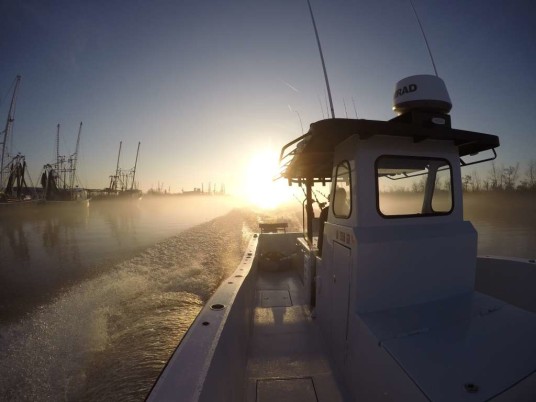
I was thrilled at the opportunity to spend a day exploring new territory with Capt. Hunter on the second day of our expedition. As a full-time charter Captain, it’s rare to find an opportunity when you can break away from the routine and test out new techniques, new numbers, and new equipment. Particularly in Venice, LA, when customers pay big dollars to go out for tuna, it’s a rare opportunity to go fun fishing. Having a day on the water with Hunter to catch up and test out some deep dropping territory was a refreshing change of pace for all of us.

The ride out in the morning put us in extremely heavy fog, which cast an opaque steam drenched glow across the marshes as we pushed through the west pass.
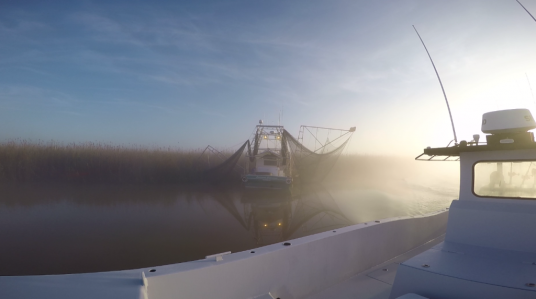
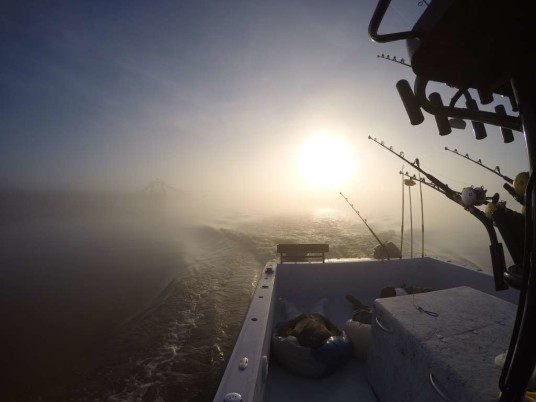
We started our second day working some of the pumping stations for wahoo in the morning, but only managed one specimen.
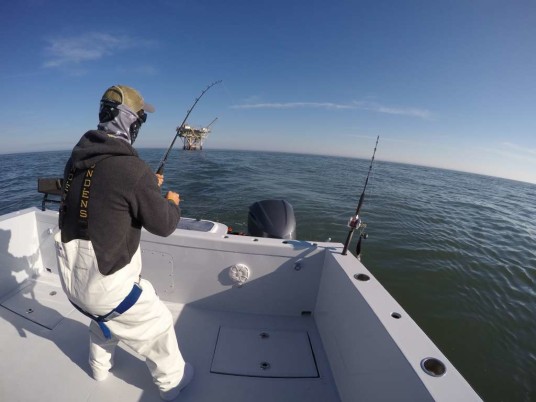
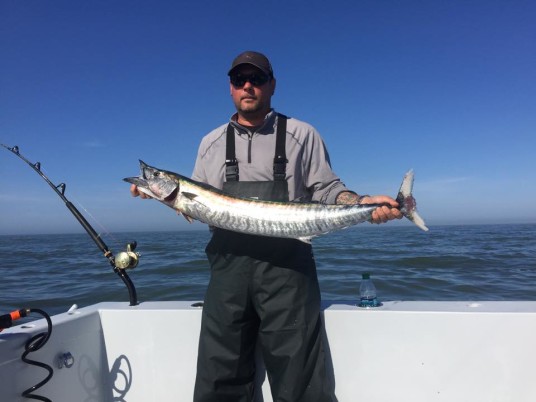 For us, it was an awesome occasion, as any wahoo would be considered a day maker in Miami, Fl! In Venice, LA – not so much. Venice, LA is home to some of the best wahoo fishing in the world – producing fish up to 80lbs on a regular basis. As Hunter explained, wahoo trolling can be very hit or miss, as the fish will often stack up on the rigs and slam baits as they come by. They’re either there and feeding – or they’re not. What’s amazing to me is that wahoo’s here on the south east Florida cost rarely touch giant trolling rapalas, but in The Gulf – they slam the hec out of them. The other major consideration for catching wahoo down here in Miami, FL is water clarity – it’s a rare occasion to find a wahoo in anything other than bluewater. In The Gulf, however, the muddy river water layers on top of blue water- creating a divide in water clarity with muck on top and clear water just below. These conditions are typically ideal for wahoo trolling around the pumping stations, but it just wasn’t in the cards for us. We made a variety of passes from different angles, changed out lures, tried different speeds, but we just couldn’t get a bite. Feeling lucky, Hunter took us to the rig where the state record wahoo had been caught just a few years earlier – the structure was brilliantly commanding in the blue water and certainly looked like prime ground for wahoo.
For us, it was an awesome occasion, as any wahoo would be considered a day maker in Miami, Fl! In Venice, LA – not so much. Venice, LA is home to some of the best wahoo fishing in the world – producing fish up to 80lbs on a regular basis. As Hunter explained, wahoo trolling can be very hit or miss, as the fish will often stack up on the rigs and slam baits as they come by. They’re either there and feeding – or they’re not. What’s amazing to me is that wahoo’s here on the south east Florida cost rarely touch giant trolling rapalas, but in The Gulf – they slam the hec out of them. The other major consideration for catching wahoo down here in Miami, FL is water clarity – it’s a rare occasion to find a wahoo in anything other than bluewater. In The Gulf, however, the muddy river water layers on top of blue water- creating a divide in water clarity with muck on top and clear water just below. These conditions are typically ideal for wahoo trolling around the pumping stations, but it just wasn’t in the cards for us. We made a variety of passes from different angles, changed out lures, tried different speeds, but we just couldn’t get a bite. Feeling lucky, Hunter took us to the rig where the state record wahoo had been caught just a few years earlier – the structure was brilliantly commanding in the blue water and certainly looked like prime ground for wahoo.
We made a few passes and marked absolutely nothing. Not even bait! Without a wahoo to be seen anywhere in the area, we made or way our to the deep dropping grounds to began our search for tile fish, yellow edge grouper, and who knows what else. There are a few boats in Venice, LA which excel at bottom fishing, and Hunter had an itching suspicion he knew where those spots might be. Deep dropping on “the west side” can be very difficult, as there’s such a tremendous volume of area where fish could reside. Our search began on bathyometric charts for territory which resembled some of the better deep dropping ground we cover here in the Atlantic. We found a few areas which looked prime – resembling walls and bottom that’s been productive for us in the Caribbean. We made a few drops using the new Hooker Electric and pulled a few nice bites, but didn’t manage any deep water specimens to the boat. The territory we fished looked legit, but again, it just wasn’t in the cards for us to be deep drop hero’s. Before we wrapped it up for day two of the expedition, we made our way to an area which looked very close to some of the ridges we’ve fished for swordfish throughout the Florida Keys.
Deep, sharp ridges on “the west side” looked ideal for swordfish – so we rigged up with a Stanczyk swordfish wind-on, prepared a strip bait, and began working the bottom. With daylight burning fast, we worked a drop off which looked to be the steepest structure in the area. Slowly bounding down the wall, we saw a slight bend in the rod, but nothing which suggested a true swordfish “whack”. We waited to see if the fish would come back – and sure enough, the rod dipped just slightly again. Suspicious, we came tight and there was a bit of weight! I was thinking small sword or some other random bottom fish, but we hauled up regardless. By the time we hit the leader, there was definitely a consistent wiggle and drag on the line – and wouldn’t you know it – there was a fish! Not a swordfish, but a truly odd deep water specimen – an Escolar!
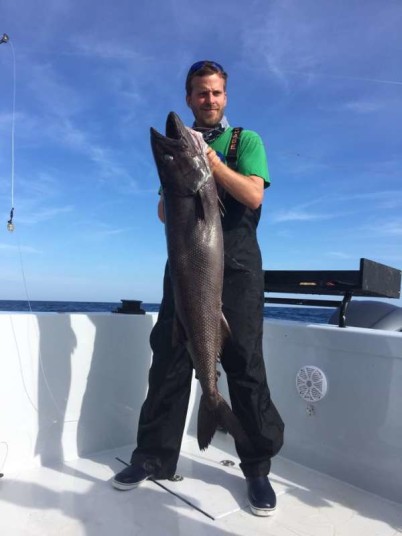
This giant nasty creature had literally engulfed our bait in one bite and was deep hooked. After a few pics, we packed it up and headed in to enjoy a wahoo dinner and a few cautious bites of the oceans “most palatable” deep water fish.
Day 3 – Legacy tuna fishing with Capt. Scott Leger
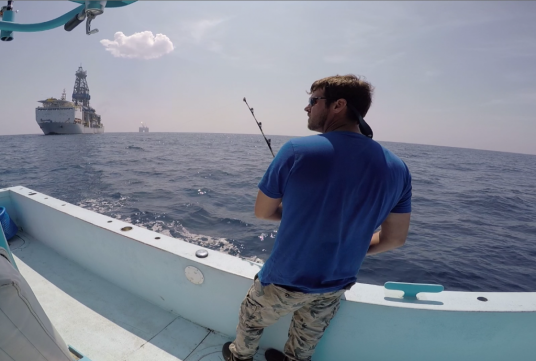
The story of Paradise Outfitters actually begins in the late 90’s when Scott Avanzino started the operation in the emerging town of Venice, LA. Largely unknown to the global sport fishing community, a few pioneers began experimenting with, and succeeding at catching giant yellowfin tunas, marlin, wahoo, mako sharks, red snappers, groupers, triple tails…well, pretty much everything that swims. Oil rig fishing in the gulf of mexico, almost two decades ago, was something few anglers had ever experienced. Today, the small muddy town of Venice, LA is now legendary – hailed as the port of choice for big game anglers who desire to test their might against the toughest predators the ocean has to offer.

In the early days, Scott Avanzino was the most successful of the pioneer fishermen out of Venice. You may have read about him in the countless magazines and news paper articles that were published at the time. You may also have encountered a photo which featured him or one of his customers with legendary catches. But, as with most impressively bold endeavors, Avanzino was by no means alone in this venture to solidify Paradise Outfitters as the leading crew of Venice, Louisiana sport fishermen. Avanzino was in some ways inadvertently, and in some ways purposefully, training the next generation of elite sport fishermen – two of those truly time tested and incredible crew members – were Scott Leger and Hunter Caballero.
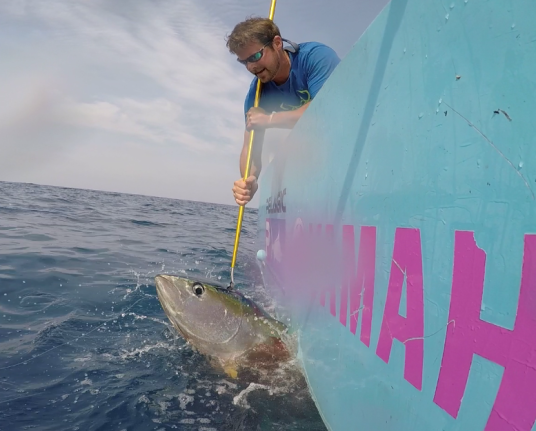
I’d met Scott Leger previously during our expeditions to Venice, but never had the privilege of fishing with him. I regret that! I’ve fished with many anglers, captains, and mates around the world, but few of them are as humble and genuinely amiable as Leger. A Louisiana native and salt-of-the-earth hard working individual, Leger has been on the Paradise Outfitters crew since the beginning. As a mate, he has boated countless trophy tunas, wahoos, makos, and the like. As a Captain, he has guided thousands of customers to catches which are legendary. As an angler, he holds the Gulf of Mexico and State of Louisiana record for Big Eye tuna – a staggering 240lb 3 oz specimen he boated with none other than Hunter Caballero. Leger’s tuna fishing experience is second to none. He is also one of the most loyal, honest, and dedicated sportfishermen you will ever meet.
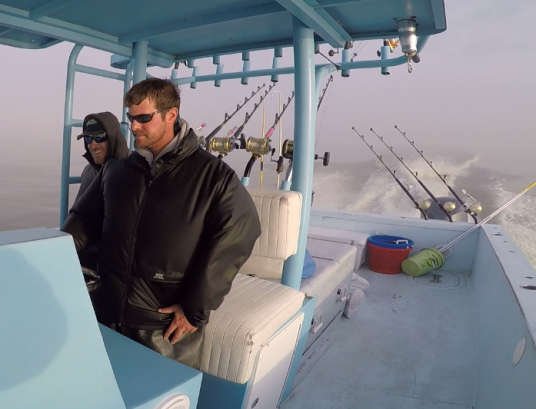
By the third day of our expedition, the rumor was that most of the larger tunas at the rigs were only feeding on live pogies and that chunk baits just weren’t cutting it. Chasing bait on the delta is a difficult endeavor, and as Leger put it, keeping a secret in Venice is impossible. Word spread quick of a small area on the west side that held bait, making it a mad dash first thing in the morning to find the coveted baitfish before anyone else. That third morning we departed the dock into some of the heaviest fog i’ve experienced on the water. Without radar, the trip out of the west pass would have been impossible. We encountered several eerie scenes of shrimp boats nestled in the grass and blind turns which barely held the beam of the original 41′ Fin Cat that Leger operates for Paradise Outfitters. We were rigged for anything, from tuna to wahoo.

Clearing the west pass put us out into the muddy shores of the gulf in search of pelicans, which we stalked for almost two hours before finding a few that seemed to share where the pogies were hiding.
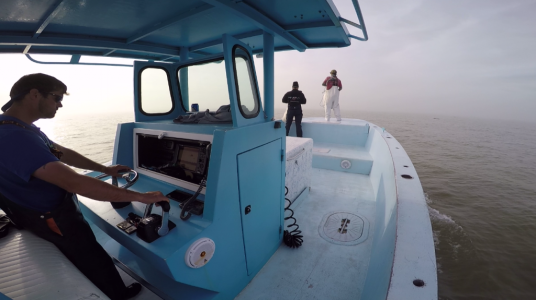
Taking turns heaving heavy cast nets, we must have thrown a dozen times in order to round up a few dozen pogies. The bait was there, and thick, but just seemed to scatter before our nets made their way to them. With daylight burning, we charged back out to the rig where the tunas had been leaping out of the water the day before. The run from the Mouth of the Mississippi to the floating rigs is not a short one, which afforded me the perfect opportunity to learn more about the legacy of sport fishing in Venice, LA as well as Leger’s personal experience with how the industry changed over time. What I found most intriguing during our conversation was how he described the change in tactics. The techniques they used to catch tunas a decade ago would hardly find a place in today’s environment. Did the fish get smarter? Are they responding to pressure? Have the feeding habits changed? It sounds that way. Leger painted a picture of an untamed wilderness, specifically recalling how fishing the midnight lump once relied on the use of a heavy mono leader, giant circle hook, and dead pogie spiraling in the current. While chunking is still effective today, fluorocarbon and small 6/0 3X strong circle hooks are the mainstay of the fleet. A spiraling dead pogie with a huge hook engorged in its head is laughable by modern standards, but worked flawlessly back then. Kite’s, for example, rarely find their way to the sky as the need to float rubber flying fish out on a line just isn’t there. The changes in tactics that Leger described echoed some of the changes i’ve experienced here in Miami, FL. For one, the bait has become increasingly more difficult to acquire. Secondly, most of the wrecks and reefs we fish today are covered up in boats, whereas a decade ago, I hardly recall seeing another vessel in sight of me when fishing down south. I suppose that’s how it goes and change is the only constant we can depend on in this rebounded and moderately shell shocked economy, but I found it striking that even in one of the most up and coming sport fishing destinations in the world – a veteran noticed their way of life changing around him. Leger asserts that the fishing in Venice, LA is actually better than he ever remembers – citing the shear volume of giant tunas he’s caught, and seen caught, in the last two years. I’m inclined to agree with him, but then again, i’m just a guest in their daily routine of catching oversized tunas that fight like freight trains.

We concluded our 45 mile run with an arrival to one of the most odd ships i’ve personally encountered. While drilling ships may be common in the Gulf of Mexico, i’d never seen one up close and personal. The “Noble Bully”, as it read across it’s stearn, is massive and has been in place for quite some time. Drilling ships provide the same structure and protection for baitfish as the floating rigs, which makes them prime targets for tuna fishermen. Arriving to the ship as helicopters circled about, taking tandem turns landing and leaving, we deployed our spread – two live pogies hooked through the bottom lip – essentially freelined. We marked fish deep around the ship, but they just wouldn’t come up to bite the slimy wiggling pogies, free drifting in 5000 feet of water. We hauled up and made the run to another drill ship which was just to the North of the URSA, where we had witnessed the giant tuna jumping bonanza on the first day of our expedition. We lined up at the front of the ship and deployed our first round of chunks to no avail. We circled around again and made a second drift. Sometimes, chunking can get monotonous. You want that bite so bad, and every pull could be the one, but your mind begins to play tricks on you. You wait, and each gentle drag of the current sends your heart racing. It’s a game of managing anxiety while staying perfectly prepared for that single instance when you must swiftly thrust the drag lever to strike, or risk losing what could be a trophy tuna. There’s just no way to know what might grab your chunk.

By our fourth bite-less drift, i’ll admit I felt worried. Not that we were doing anything wrong, but i’m used to fish shutting down on us. It happens in Miami, FL all the time. Whether it’s the current, the bait, the moon, the water temperature, or any other myriad of factors – fish can just “turn off” and there’s nothing you can do about it. The rumors of the bite shutting down were fluttering in my mind, but in an instant, it all changed – the line ripped out of my hands and instinctually (hey, I was impressed it actually happened like that), my right hand nudged the drag lever to strike and the fish began ripping. Hooked up! I moved the rod to the belt and was pleased to find an angry tuna jockeying against me. Just a few minutes into the fight – Todd comes tight too! Adjacent to me on the gunnel, his fish is acting a bit funny. He wasn’t sure whether it was a small fish, or if he was tangled in my line. We frantically began to “unwrap” the line crossing before it cost us what felt like a decent fish. As I worked the fish up from the depths, without much relief from heavy pressure, it became apparent that this fish had made the terrible mistake of ingesting two baits with hooks! This tuna was double hooked between myself and Todd – after a few more minutes, the fish was in the boat – with two circle hooks vested in the corner of its mouth. A fitting end to a gluttonous tuna!
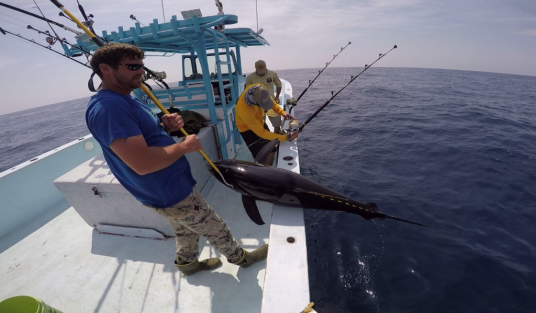

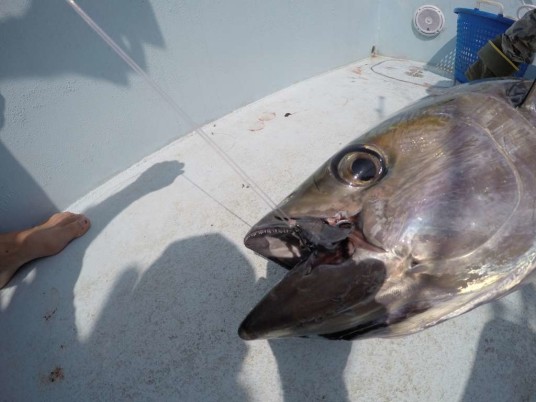
After working hard to get the bite at the drilling ship, and with time winding down on the third day of our expedition, we made the run South to the URSA – leaving the drilling ship behind for other Captains to work. We arrived and began immediately marking fish – chunks out but no bites. One of the amazing skill sets of the Paradise Outfitters crew is to understand where to position the boat in order to draw a strike. After our first drift not producing any fish, Leger moved us closer to the rig on the north side, drifting with the current, slowly to the south. As if on queue during the next drift – my rod loads up and the drag on the 50W tiagra starts screaming. It’s a BIG fish. Ripping drag on the 50 for 30 seconds – I call for the harness and strap in. The fight is on and the fish is HEAVY.
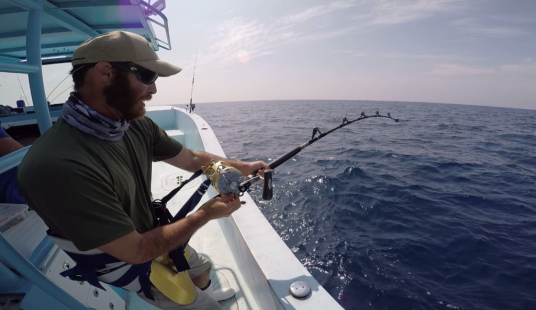
When you’re tired, as you should be after several days of tuna fishing in Venice, LA, big fish feel even bigger – but there was no doubt in my mind. This was a serious tuna. Each gain led to another pull. I would bring in 10 yards, the fish would take 15.

This tug of war went on for about 25 minutes before the fish finally showed some color – big sickles, a mean head, and a furious head beat which signified it was getting tired. Watching the fish go broad side to me, just 100 feet down, burned the image of that tuna into my mind. I began to recall the moment I first saw the 145lbr I caught with Hunter the previous Fall – a furious tuna pulling with all of its primordial strength to return home – to the depths. My legs were straining from sitting down on the fish in the harness, but my arms and back were fine. Being careful not to apply too much drag, I lifted the fish and was able to put prime pressure just as he went weak. Up pops the beast and Leger is there with a swift gaff shot to the head. Done. Up and THUD on the deck he goes. A prime ~ 70lb yellowfin.
We were ecstatic – not because we had the fish in the boat, but because we knew there were more coming.
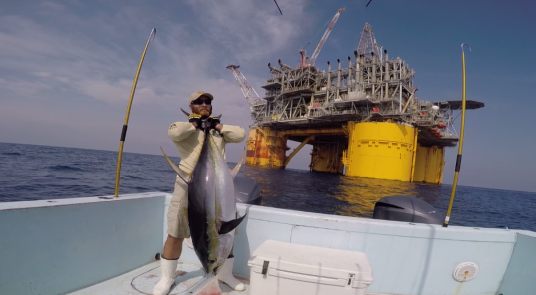
We iced down the fish and circled right back around to the corner. Chunks out – this time – Scott gets nailed and the fight is on! Another bruiser fish ripping line into the deep. Leger had them dialed, and we knew it was about to get epic.
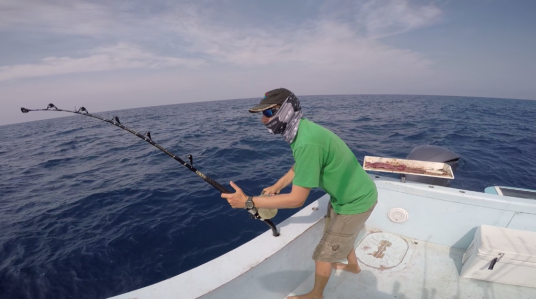
Scott Virgin has caught many incredible fish through the years and i’ve been fortunate to be with him for many of those occasions. Never in my life had I seen him as ecstatic as he was on this occasion. The tuna would rip line, and Scott would smile like he just won the lottery. The tuna would dog him, and Scott would laugh. It’s a humbling feeling to watch an angler who is so lost in the moment that everything else fades away and nothing else matters. That’s what big game fishing is all about, particularly tuna fishing on the Oil rigs. Leger gets it. Caballero gets it. It’s a feeling of freedom. A fleeting feeling that your heart and mind remember, but your body forgets, until you feel the weight of the fish and hear the scream of the drag. Unstoppable.

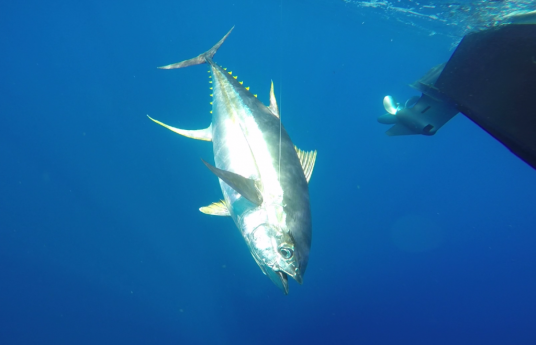
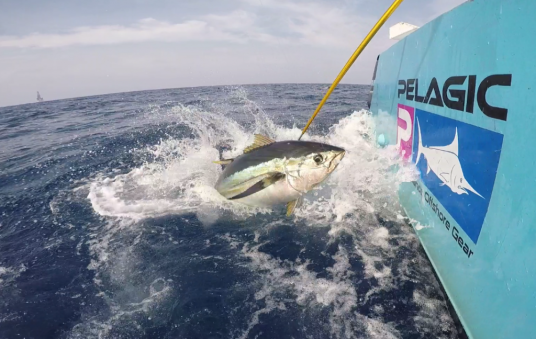
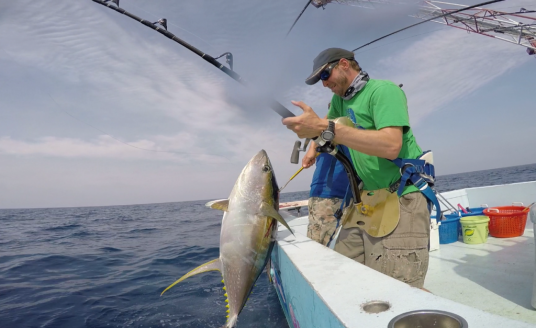
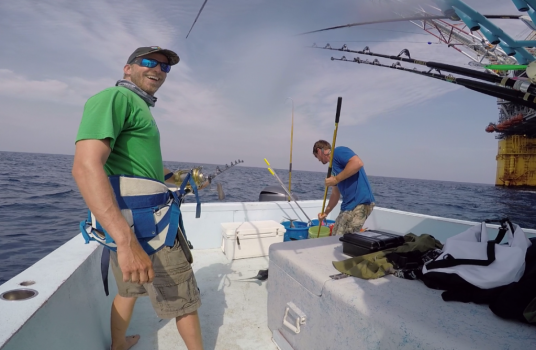
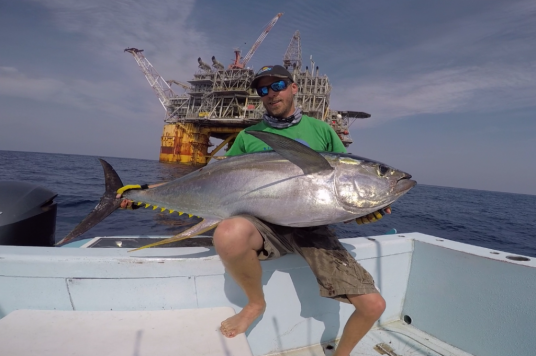
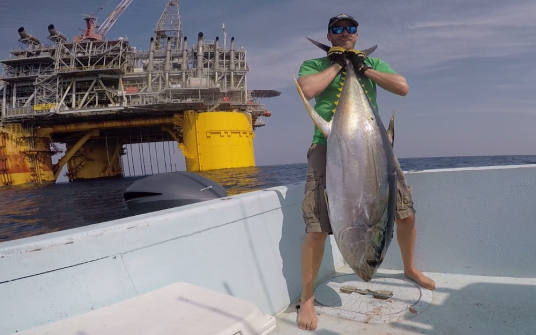
Scott’s fish was a beauty – a magnificent specimen which captured the conclusion of our expedition in full glory. Giant yellowfin tuna fishing in Venice, LA is not for the mentally or physically unprepared. It is a privilege. An experience which slowly evolves into an addiction. The crew of Paradise Outfitters is addicted – they do this not because they have to, but because they want to. Because every morning, they still love it. They still give everything they have to give to share the remarkable experience of big game fishing with those who seek the ultimate sport fishing thrill. There are few places in the world you can travel where the contrast between humanity and nature is as profound as the super structures towering above the endless ocean – harboring both predators, and prey.
How do I even tell this story? In many respects, I can’t. No matter what i’ve written here – my memory is so overwhelmed with the details of the expedition that to capture all of it is just impossible. The experience of fishing with the Paradise Outfitters crew is indescribably amazing. If you sit back and imagine the perfect fishing charter operation – it would be difficult to imagine anything other than this. But it’s not just about the business, or the fishing. It’s not just about the enchanting moments of flying through the fog in the baddest boats on the planet, the chill of the marsh air against your face as you charge towards the most unbelievable fishing in the gulf of mexico. It’s about something greater. That feeling of holding a rod while a monster yellowfin grabs your popper off the surface just yards from the boat. That feeling of watching your friends catch their fish of a lifetime. That feeling of knowing that it’s not over – that even if this expedition comes to an end – that’ we’ll get to come back. This journey into the heart of the Gulf of Mexico is just one episode – one taste of the life Paradise Outfitters lives every day. We are privileged to have joined them, again – Hunter, Scott, and the rest of the crew – to experience their way of life, their legacy.
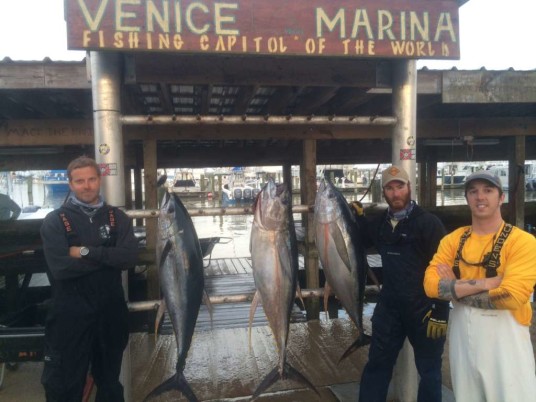
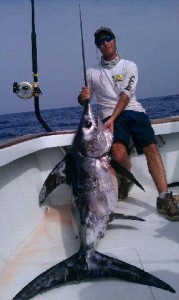
Capt. Charlie Ellis

Latest posts by Capt. Charlie Ellis (see all)
- Curious how to catch or buy live bait in Miami, Florida? Here’s what you need to know! - October 28, 2016
- A Legacy of Venice Louisiana Tuna Fishing - April 7, 2015
- Four Miami, FL Fall Fishing Tips - September 2, 2014
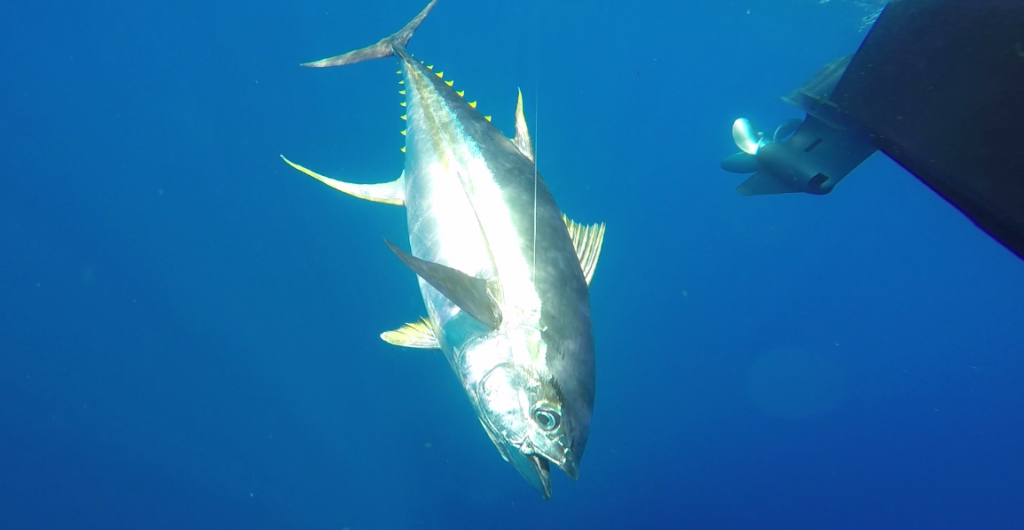
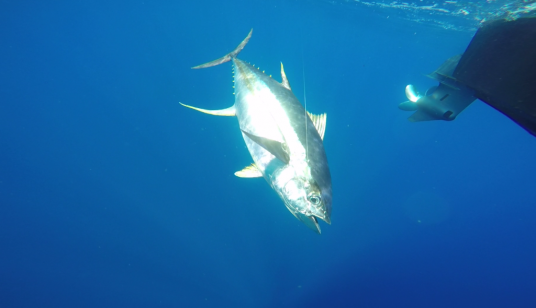
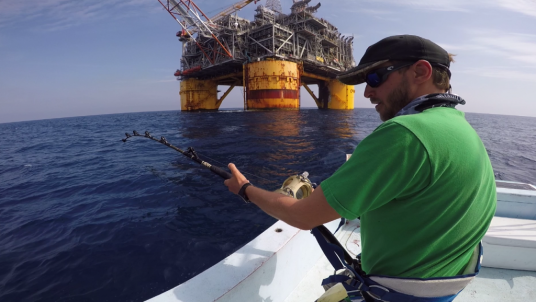
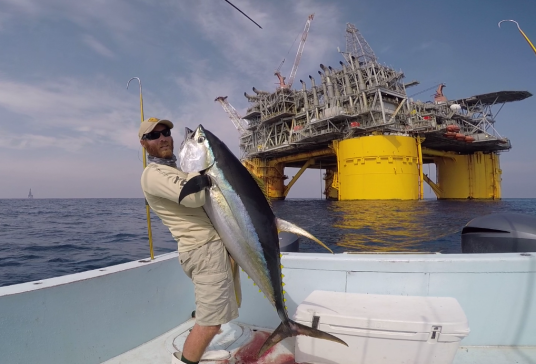
Comments